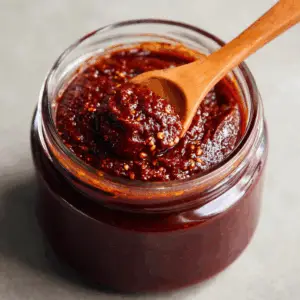
Homemade Gochujang Fermented Chili Paste
Equipment
- Large non-reactive pot (like stainless steel or enameled cast iron) For cooking the rice porridge.
- Wooden spoon or heat-resistant spatula For constant stirring during the cooking phase.
- Mixing bowl (large) To combine all the ingredients.
- Fermentation container (earthenware or food-grade plastic or glass) Traditionally, Koreans use an onggi (fermentation crock), but a large mason jar or a BPA-free plastic container will also work.
- Cheesecloth or breathable cover To let gases escape during fermentation.
- Rubber band or string To secure the cloth over the container.
Ingredients
- 2 cups sweet rice flour also called glutinous rice flour – This creates the base paste and lends a slightly sweet chewiness to the final product.
- 6 cups water – Used to create a rice porridge that becomes the body of the paste.
- 1 ½ cups malt barley syrup yeotgireum or rice syrup – Adds sweetness and aids in fermentation.
- 2 cups fermented soybean powder meju garu – This is what gives gochujang its signature funk and depth.
- 3 cups gochugaru – Korean red pepper flakes; choose medium or coarse grind for best texture.
- ½ cup sea salt – Helps preserve the paste and balance the sweetness.
- Optional: 2 tablespoons rice wine or soju – Can be added to prevent mold during fermentation.
Instructions
Make the Rice Porridge
- In a large pot, combine the sweet rice flour and water. Stir continuously over medium heat until the mixture thickens into a smooth porridge—this takes about 10 to 15 minutes. It should resemble a thick pudding.
Cool the Porridge
- Remove the pot from heat and let it cool to just above room temperature. If it’s too hot, it can kill the beneficial microbes in the meju powder.
Add Sweetener and Soybean Powder
- Stir in the malt barley syrup, then slowly mix in the meju powder until well combined. Make sure there are no lumps. The color should shift to a muted beige-brown.
Add Gochugaru and Salt
- Gradually fold in the gochugaru and sea salt. This part is messy but essential. Mix thoroughly so the chili flakes are fully incorporated. The paste will deepen to a rich crimson color.
Transfer and Ferment
- Spoon the mixture into your fermentation vessel. Flatten the surface with a spoon to eliminate air pockets. If using a large crock or jar, leave at least 1–2 inches of headspace. Cover with cheesecloth and secure with a rubber band.
- Place the jar in a cool, dry, and preferably sunlit spot. In Korea, jars are often left outside to ferment under natural conditions, but a warm windowsill or pantry works too.
Ferment for 6 to 8 Weeks
- Let your gochujang ferment for at least two months. Stir it once a week with a clean spoon to keep mold from forming and to redistribute flavors. If you notice white mold on the top, simply skim it off—it’s usually harmless yeast.
- After 2 months, the flavor will be complex, slightly sweet, salty, and deeply savory with a balanced heat. You can transfer it to smaller jars and store in the fridge, where it will continue to age slowly and develop even more character over time.